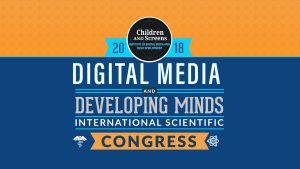
Children and Screens: Institute of Digital Media and Child Development brought together an incredible mix of neuroscientists, educators, public health experts, data scientists and more for the Second National Congress of Digital Media and Developing Minds, focusing on the impact of digital media on children and covering the latest empirical research and solutions. The gathering included 200+ people from thirteen countries, with keynotes and panels covering topics such as misinformation, internet and gaming addiction, cyber-bullying, depression and suicide, and health-promoting uses of media.
The Congress took place from October 15 – 18, 2018, and was held by Children and Screens: Institute of Digital Media and Childhood Development, the leading independent interdisciplinary research organization in this field, in partnership with Cold Spring Harbor Laboratory, which hosted the gathering in northern Long Island. This follows the first Congress, which took place in 2015 at the National Academy of Sciences, and comes as the public is reckoning with issues of privacy concerns, the growing power of tech companies, and children as young as two becoming heavy users of video games, smartphones, and later social media.
“We have come to answer the three fundamental questions,” said Dr. Pamela Hurst-Della Pietra, President and Founder of Children and Screens, in opening remarks. “First, how are digital media enhancing or impairing children’s ability to live happy, healthy, and productive lives? Second, how are years of electronically-mediated interactions shaping children’s physical, cognitive, psychological, social, emotional, and behavioral development? And third, what should we do about it?”
Attendees had a chance to present research and also collaborate with others on how to better study, measure, and evaluate outcomes of children’s interaction with various technologies. One of the event’s most significant outcomes was a bold, collaborative effort to develop a new Media Screening Toolkit, with a suite of innovative instruments for screening, monitoring and measuring media habits in children.
For the first time, the Congress included a Tools and Methodologies Exposition and hands-on workshop to show off the latest tools and technology for scientific research.
Exposition participants demonstrated the latest tools being used to study media’s impact on toddlers, children and adolescents, as well as advances in audio and video monitoring and wireless communications. Companies exhibiting included BIOPAC Systems, Movisens, MindWare, Tobii Pro, and others.
The Congress raised many important questions that are highly relevant for today’s device-saturated world. There was consensus that a “whole child” approach to youth media research would provide a comprehensive understanding of how digital media affect developing minds, giving us answers about attachment and emotional regulation, physical health and wellbeing, sleep, weight management and more.
At the conclusion of the four-day event, Dr. Pamela Hurst-Della Pietra of Children and Screens noted that the work of so many attendees was becoming more public and having a lasting impact.
“The intergenerational character of this event and its institutional and geographic diversity also reassure me,” she said. “Many more countries are represented here than at the first national Congress three years ago. The world is here. Word is spreading. More eyes are turning to this subject and more children will benefit as a consequence. This is terrific news.”